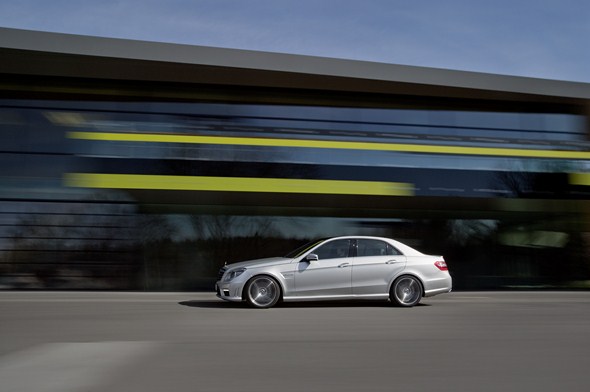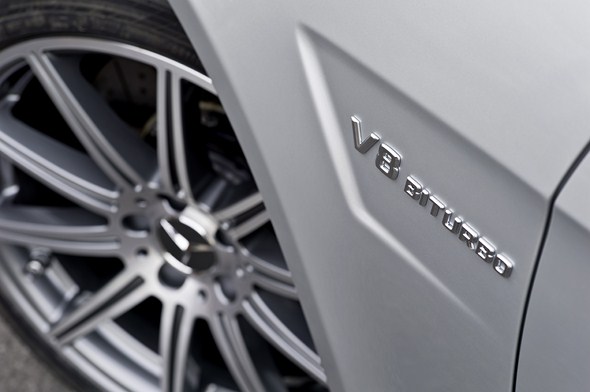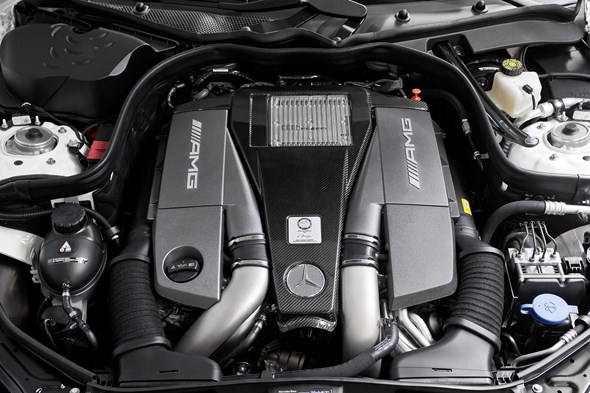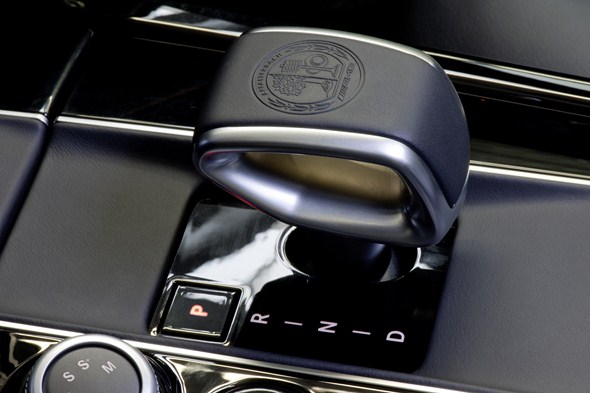

The benchmark for dynamism and efficiency
The Mercedes-Benz E 63 AMG is now even more powerful and efficient. As part of the “AMG Performance 2015” model strategy, the high-performance car now benefits from the new AMG 5.5-litre V8 biturbo engine. This unit, already familiar from the CLS 63 AMG, delivers an output of 386 kW (525 hp) to 410 kW (557 hp), together with an impressive reduction in fuel consumption: the E 63 AMG consumes 9.8 litres per 100 kilometres (Estate 10.0 litres) according to NEDC combined, in other words 22 percent less than its predecessor with the AMG 6.3-litre V8 naturally aspirated engine.

As a result the E 63 AMG, which is available in Saloon and Estate variants, is the most efficient vehicle in its class.
An important contribution to this is also made by the AMG SPEEDSHIFT MCT 7-speed sports transmission, and the newly developed electromechanical AMG speed-sensitive sports steering system.
Additional assistance systems now also raise occupant safety to a whole new level.
This eight-cylinder powerhouse, designated internally as the M 157, boasts a combination of innovative high-tech components: in addition to spray-guided direct petrol injection with piezo injectors, these include a full aluminium crankcase, four-valve technology with camshaft adjustment, air/water intercooling, generator management and stop/start system.
With a displacement of 5461 cc, the eight-cylinder engine develops a peak output of 386 kW (525 hp) and torque of 700 Nm.

In conjunction with the optional AMG Performance package, these figures increase to 410 kW (557 hp) and 800 Nm.
Both variants of the E 63 AMG achieve exceptional performance: acceleration from zero to 100 km/h takes
4.3 and 4.2 seconds respectively (Estate: 4.4 and 4.3 seconds), and the top speed is 250 km/h (electronically limited).

A quick glance at the technical data reveals the tremendous accelerating power of the eight-cylinder biturbo engine: no less than 700 Nm of torque can be called upon across a broad engine speed range from 1750 to 5000 rpm.
When combined with the AMG Performance package, the driving experience becomes even more impressive: now precisely 800 Nm of torque is available between 2000 and 4500 rpm.
The result is effortlessly superior power delivery, which can be enjoyed in manual “M” transmission mode in particular.
Key data at a glance:
| E 63 AMG | E 63 AMG Estate | |
| Displacement | 5461 cc | 5461 cc |
| Bore x stroke | 98.0 x 90.5 mm | 98.0 x 90.5 mm |
| Compression ratio | 10.0:1 | 10.0:1 |
| Output | 386 kW (525 hp) at 5250-5750 rpm
410 kW (557 hp) at 5250-5750 rpm* | 386 kW (525 hp) at 5250-5750 rpm
410 kW (557 hp) at 5250-5750 rpm* |
| Max. torque | 700 Nm at 1750-5000 rpm
800 Nm at 2000-4500 rpm* | 700 Nm at 1750-5000 rpm
800 Nm at 2000-4500 rpm* |
| Engine weight (dry)
| 204 kg | 204 kg |
| Fuel consumption NEDC combined
| 9.8 l per 100 km | 10.0 l per 100 km |
| CO2 emissions
| 230 g/km | 234 g/km |
| Acceleration 0 – 100 km/h
| 4.3 s 4.2 s* | 4.4 s 4.3 s* |
| Top speed** | 250 km/h | 250 km/h |
* with AMG Performance package; ** electronically limited
Fuel consumption reduced by 2.8 litres per 100 km
Despite its increased output, higher torque and improved performance, the new E 63 AMG shows an improvement of 2.8 litres in fuel efficiency compared with the previous model with V8 naturally aspirated engine.
Fuel consumption, at 9.8 litres per 100 kilometres according to NEDC combined, corresponds to CO2 emissions of 230 grams per kilometre (Estate: 10.0 l/100 km; 234 g/km).

Both variants achieve the same consumption and CO2 figures either with or without the AMG Performance package. As a result, the E 63 AMG takes the lead in a competitive comparison.
The improvement in output and torque that comes with the AMG Performance package is due primarily to an increase in the maximum charge pressure from 1.0 to 1.3 bar.
Visible differentiation is provided by the engine cover in genuine carbon fibre. The AMG Performance package also includes the AMG Performance steering wheel with black Alcantara in the grip area, red-painted brake callipers and, in the case of the Saloon, the genuine carbon fibre AMG spoiler lip on the boot lid and the electric rear window blind.

AMG SPEEDSHIFT MCT 7-speed sports transmission helps save fuel
A major contribution to the car’s exemplary consumption figures is also made by the AMG SPEEDSHIFT MCT 7-speed sports transmission. In place of a conventional torque converter, this uses a compact wet start-up clutch.
The E 63 AMG also features a stop/start function as standard: this is active in the Controlled Efficiency (“C”) transmission mode and switches the eight-cylinder engine off when the vehicle comes to a standstill.
The stop/start function can be activated or deactivated using the ECO button on the centre console.

When in transmission mode “C”, the vehicle will always start up in second gear. The system will also change gears noticeably early and avoid high engine speeds.
Demand-driven delivery of fuel and a generator management system with braking energy recuperation during deceleration add further to the economic use of fuel.
Driving dynamics certainly don’t suffer as a result: the transmission modes “S” (Sport), “S+” (Sport plus) and “M” (Manual) enhance the car’s agility quite noticeably.
Shorter response times, higher engine speeds and more spontaneous gear changes demonstrate the full potential of the new AMG V8 biturbo engine.

In all three transmission modes, not only is the stop/start function deactivated but, at full load, the engine management system partially suppresses the cylinders.
This carefully managed interruption to ignition and injection results in faster gear changes and an emotive acoustic effect. The automatic double-declutching function in reverse gear provides the perfect complement.
AMG RIDE CONTROL sports suspension and new steering system
The E 63 AMG features the AMG RIDE CONTROL sports suspension with a specially designed front axle: the track has been widened by 56 millimetres compared with the E 500, and includes independent wheel carriers, for increased negative camber at the front, giving clear benefits in terms of grip when driving fast through bends.
Further features include steel suspension struts on the front axle and air suspension struts on the rear axle, with an automatic level control system. Also standard here is an electronically controlled damping system, which automatically adjusts the damping characteristics depending on the driving situation and reduces the roll angle of the body.
The result: lightning-fast adjustment between optimum driving comfort and the best possible agility. The driver can switch between the suspension modes of “Comfort”, “Sport” and “Sport plus” at the touch of a button.
The steering system on the E 63 AMG is also new: the electromechanical AMG speed-sensitive sports steering features a more direct ratio of 14:1 and variable power assistance that adapts according to the suspension mode.
The result: extremely agile handling through bends. The steering also helps to reduce fuel consumption, since the power assistance system only draws power when the vehicle is actually being steered.
As well as the 3-stage ESP® system with SPORT handling mode, the standard equipment package includes an AMG high-performance braking system, with composite technology on the front axle.
An even more powerful AMG ceramic high-performance composite braking system, 40 percent lighter in weight, is available as an option.
Optimum grip comes courtesy of the new 18-inch AMG light-alloy wheels in a 10-spoke design, fitted with 255/R 40 R 18 tyres on the front and 285/35 R 18 on the rear.
The “flowforming” production process already used with the SLS AMG and the CLS 63 AMG optimises the durability of the light-alloy wheels, while also reducing weight by up to 0.8 kilograms per wheel.
The reduced unsprung masses help to improve both driving dynamics and ride comfort.
Decidedly dynamic exterior
Externally, the E 63 AMG with the new M157 engine is identifiable by its new 10-spoke light-alloy wheels and by the “V8 BITURBO” lettering on its distinctive, wider front wings.
Further characteristic features to aid recognition include AMG bodystyling with a specific design for the front and rear, along with AMG side sill panels and an AMG sports exhaust system with two chrome-plated twin tailpipes.
Significantly upgraded interior
A striking feature of the interior is the new AMG Performance steering wheel in a three-spoke design. The rim of this wheel, which is already used in the CLS 63 AMG, is flattened at both top and bottom to facilitate even better control of the vehicle.
Further identifying features of the new steering wheel: aluminium shift paddles, the perforated leather in the grip areas and the three-dimensional design of the airbag cover with its “Silver Shadow” metallic trim element.
This is complemented by the new E-SELECT shift lever with embossed AMG badge on the centre console.

Similarly adopted from the CLS 63 AMG is the three-dimensional full-colour TFT display in the centre of the speedometer. The driver is welcomed by a striking AMG logo that shows here as soon as the door is opened.
AMG Performance Studio: individuality ex factory
Special optional extras from the AMG Performance Studio can also be added ex factory to give the E 63 AMG even more individual flair:
- AMG RIDE CONTROL Performance suspension
- AMG light-alloy wheels in a new 10-spoke design, painted in titanium grey with a high-sheen finish, with 255/35 R 19 (front) and 285/30 R 19 (rear) tyres
- AMG rear axle locking differential with 40 percent locking action
- AMG ceramic high-performance composite braking system
- AMG Exterior Carbon package
- AMG Performance steering wheel
- AMG trim elements in carbon fibre/black piano lacquer
- Illuminated AMG door sill panels
- AMG Driver’s package (includes restriction of the top speed to 280 km/h (E 63 AMG Estate) or 300 km/h (E 63 AMG Saloon), participation in a driver training course at the AMG Driving Academy, AMG spoiler lip and electric sunblind for rear window (both for E 63 AMG Saloon only)
New driving assistance systems for added safety
With immediate effect, over a dozen driver assistance systems in the E 63 AMG help to avoid traffic accidents or mitigate the severity of an accident.
Among the new systems are Active Blind Spot Assist and Active Lane Keeping Assist. Active Blind Spot Assist warns the driver if the short-range radar sensors detect that there is a risk of collision should the vehicle change lanes.

If the driver ignores these warnings and comes dangerously close to the vehicle in the next lane, Active Blind Spot Assist will intervene. By applying braking force to the wheels on the opposite side of the vehicle, controlled through the 3-stage ESP® system, a yaw movement is created which counteracts the collision course.
Active Lane Keeping Assist is also linked to the 3-stage ESP®. This system kicks into action if the driver inadvertently drifts over a solid line to the right or left of a lane.
In this case, Active Lane Keeping Assist brakes the opposite wheels and thereby prevents the vehicle from crossing the line. A display on the instrument cluster warns the driver at the same time.
If broken lane markings are crossed, the system controls an electric pulse generator in the steering wheel which generates vibrations for a short time – a discreet but highly effective cue to countersteer immediately.
Before the braking system intervenes, the steering wheel always vibrates to provide a warning.

The E 63 AMG with the new AMG 5.5-litre V8 biturbo engine is available in either Saloon or Estate versions, with the market launch beginning in September 2011. Sales prices remain at the same level as for the previous model (all prices shown inclusive of 19% VAT):
- E 63 AMG Saloon: 105,791 euros
- E 63 AMG Estate: 108,409 euros
- AMG Performance package: 8306.20 euros
- AMG Driver’s package: from 3213 euros
- Direct petrol injection with piezo-electric injectors and spray-guided combustion
- Biturbocharging with air/water intercooling
- Sophisticated engine electronics with Controlled Efficiency start/stop function and generator management
- Aluminium crankcase with ventilation holes to reduce friction
- Continuous camshaft adjustment on the intake and exhaust sides
- Demand-controlled engine oil pump
- AMG SPEEDSHIFT MCT 7-speed sports transmission with compact start-up clutch and three transmission modes






